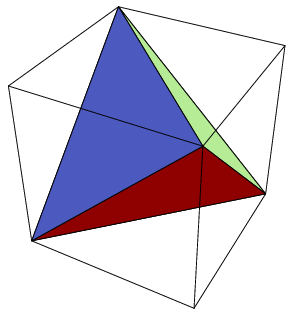 login/create account
login/create account
Simplexity of the n-cube
 -cube into
-cube into  -simplices?
-simplices? A decomposition of a polytope  into
into  -simplices is a set of
-simplices is a set of  -simplices which have pairwise disjoint interiors and have union equal to
-simplices which have pairwise disjoint interiors and have union equal to  . This is also known as a (generalized) triangulation.
. This is also known as a (generalized) triangulation.
Let  be the minimum cardinality of a decomposition of the
be the minimum cardinality of a decomposition of the  -cube into
-cube into  -simplices (the answer to our question). It is trivial that
-simplices (the answer to our question). It is trivial that  and easy to see that
and easy to see that  . A 3-dimensional cube may be decomposed into five simplices by cutting off every other corner as shown in the figure (from [JW]). This division is optimal, so
. A 3-dimensional cube may be decomposed into five simplices by cutting off every other corner as shown in the figure (from [JW]). This division is optimal, so  .
.

Chopping off every other corner of a 4-cube leaves a 16-cell (the 4-dimensional cross-polytope) which can then be decomposed into eight simplices (fix a vertex  and then take each of the eight 4-simplices formed as the convex hull of
and then take each of the eight 4-simplices formed as the convex hull of  and a facet which is not incident with
and a facet which is not incident with  ). This is also optimal, so
). This is also optimal, so  . Computer assisted searches have yielded other good decompositions in low dimensions (see [S]).
. Computer assisted searches have yielded other good decompositions in low dimensions (see [S]).
The decompositions of the 3 and 4-dimensional cubes described here do not generalize to higher dimensions. However, there is a naive decomposition of an  -cube into
-cube into  simplices. Take the cube to be
simplices. Take the cube to be ![$ [0,1]^n $](/files/tex/c8f4ec48bff464d0c9f5e1ff1cba84bb5cdea394.png) and let
and let  be the set of all points
be the set of all points  for which
for which  . Then
. Then  is a simplex contained in our cube which contains the main diagonal from the origin to
is a simplex contained in our cube which contains the main diagonal from the origin to  . Further, by permuting the terms
. Further, by permuting the terms  in the chain of inequlities, we get a total of
in the chain of inequlities, we get a total of  simplices which form a decomposition of the cube.
simplices which form a decomposition of the cube.
This naive decomposition is not optimal in dimensions 3 and 4 since our constructions show  and
and  . Haiman [H] found a clever way to lift efficient lower dimensional decompositions to high dimensions thus achieving a significant improvement on our
. Haiman [H] found a clever way to lift efficient lower dimensional decompositions to high dimensions thus achieving a significant improvement on our  upper bound. To state his result precisely, we require another parameter. Let
upper bound. To state his result precisely, we require another parameter. Let  be the minimum cardinality of a decomposition of an
be the minimum cardinality of a decomposition of an  -cube into
-cube into  -simplices with the following additional constraints:
-simplices with the following additional constraints:
- \item Every vertex of a simplex is a vertex of the cube. \item The intersection of any two simplices is a face of both of them.
It is immediate that  , but to the best of our knowledge these parameters may always be identical. Indeed, this is a separate interesting question. Anyway, back to Haiman's bound. He proved that
, but to the best of our knowledge these parameters may always be identical. Indeed, this is a separate interesting question. Anyway, back to Haiman's bound. He proved that  . Using this inequality with either the 3 or 4-dimensional example from above would give an improvement on the
. Using this inequality with either the 3 or 4-dimensional example from above would give an improvement on the  upper bound. However, best known is to plug in
upper bound. However, best known is to plug in  , which gives a general upper bound of
, which gives a general upper bound of  .
.
A natural lower bound on  can be obtained by a volume argument. Clearly,
can be obtained by a volume argument. Clearly,  must be at least the volume of an
must be at least the volume of an  -dimensional cube divided by the volume of the largest simplex it contains. Smith [S] improved upon this by moving the argument to hyperbolic space (where the volume of a cube is comparatively much larger than that of a simplex). His volume estimate here yields
-dimensional cube divided by the volume of the largest simplex it contains. Smith [S] improved upon this by moving the argument to hyperbolic space (where the volume of a cube is comparatively much larger than that of a simplex). His volume estimate here yields  .
.
Bibliography
[H] M. Haiman, A simple and relatively efficient triangulation of the n-cube, Discr. Comp. Geom. 6, 4 (1991) 287-289.
[JW] Jackson, Frank and Weisstein, Eric W. "Tetrahedron." From MathWorld--A Wolfram Web Resource.
[S] W. Smith, A lower bound for the simplexity of the n-cube via hyperbolic volume.
* indicates original appearance(s) of problem.

 Drupal
Drupal CSI of Charles University
CSI of Charles University